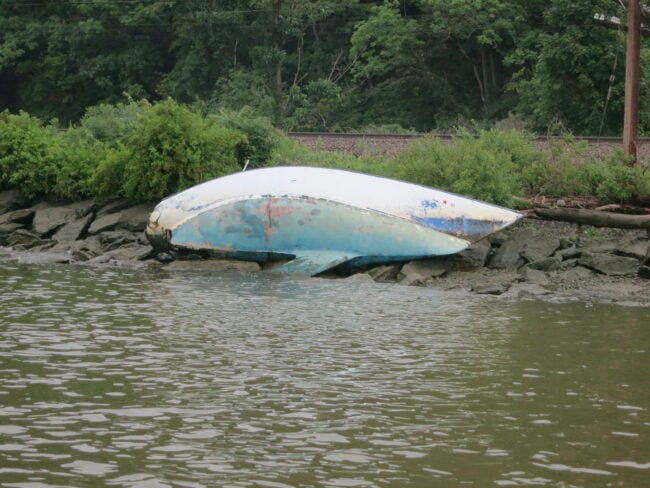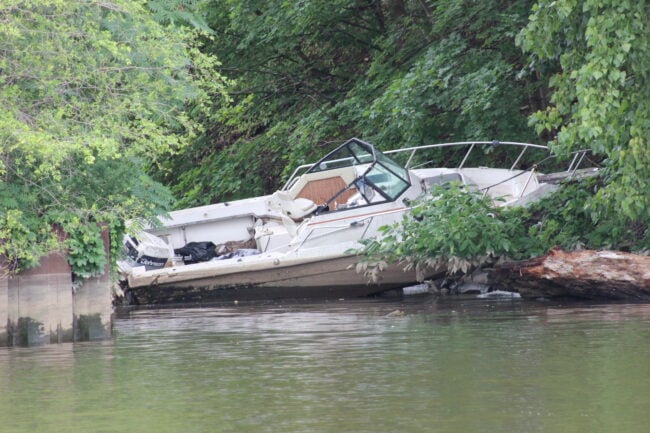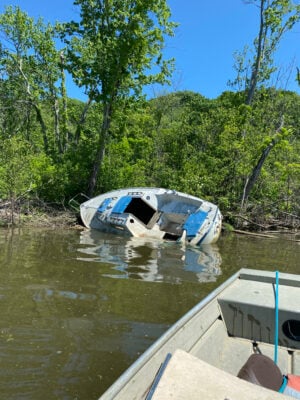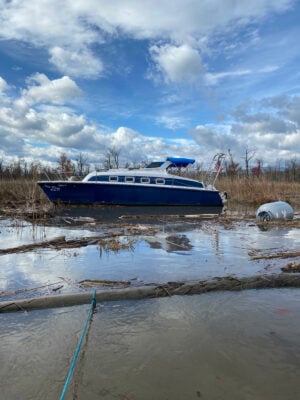Abandoned boats in the Hudson: Riverkeeper initiative recovers 18 vessels

View more images on our Flickr site
With support from NOAA and other partners, Riverkeeper is helping to rid the river of derelict vessels that cause ecological damage and navigational hazards.
In a new initiative, Riverkeeper succeeded in removing 17 sunken and abandoned boats from the Hudson in 2022, helping to address a source of ecological damage and pollution. Earlier this month, January 2023, yet another vessel was removed when a local marine contractor stepped forward to join the effort, and – as he put it – give back to the river that provides his livelihood.
Together we’re trying to deal with a difficult problem that has no easy fix, and that occurs nationwide: fiberglass boats left to pollute waterways, with no one taking responsibility for their removal. Officials in Virginia, for example, are aware of at least 230 derelict vessels, and believe many more are out there, NPR reported last week. Listen to the story here.
These vessels can create problems by blocking navigational channels, damaging ecosystems, causing visual blight, and diminishing an area’s recreational value, notes the National Oceanic Atmospheric Administration. Left unaddressed, the boats will likely sink, leak contaminants, release debris, and remain are a source of tons of plastic pollution for years.
Thankfully, NOAA’s Marine Debris Program supported the 2022 removal operations by Riverkeeper and partners, including the City of Hoboken, Sea Tow and the NY-NJ Harbor and Estuary Program of the Hudson River Foundation. The projects are described below.
Weehawken Cove: 14 vessels removed
In New Jersey, Riverkeeper, the City of Hoboken and multiple partners collaborated to remove sunken boats and marine debris from Weehawken Cove, long used as a boat graveyard. The project aimed to eliminate the potential release of harmful metals and chemicals, such as oil and mercury, as well as plastics and fiberglass, thereby helping to restore the local ecosystem. Read more here.
Rondout Creek and the mid-Hudson: 3 vessels removed
After Hurricane Irene in 2011, a sailboat (below) was stranded on the Hudson River shoreline at Sturgeon Point in Rhinecliff, visible to Amtrak passengers traveling through ever since. During Irene, flood waters in Rondout Creek caused the boat to break free from its moorings. In November 2022, it was finally removed by Sea Tow operator Joe Thomas, based in Kingston on the Rondout, also with funding from NOAA.

Two years ago, a small outboard power boat (below) was abandoned on the south bank of the Rondout across from the Hudson River Maritime Museum in Kingston, under the Route 9 bridge. This boat, too, was removed by Sea Tow in November.

In what we believe was another storm casualty, a 25-foot sailboat (below) was stranded in the marsh about a mile north of the Rip Van Winkle Bridge in Hudson, N.Y. We had hoped to remove this wreck under the NOAA grant, but in the end, the funding was not sufficient. We were resigned to living with that wreck until further funding could be secured.

But just last week, Randy King Jr., owner of Madeline Marine in Verplanck, stepped up. He notified me that his crane barge and equipment were in Saugerties, finishing a job, and offered to retrieve the stranded sailboat at no cost.
This was a stroke of luck for the Hudson River. The stars had to align on the same day: an incredibly generous marine contractor, unusually high tides, calm winds, and a warm spell, which held back ice. On January 5, Madeline Marine succeeded in removing the boat.
Randy said to me: It’s my pleasure to give back to the river, which gives me my livelihood.
Catskill Creek: Catamaran removed
Over a year ago, in late November 2021, I was southbound on patrol when a nor’easter passed through and resulted in a very high flow out of Catskill Creek.
When I arrived in Catskill I saw a 35-foot catamaran aground in Ramshorn marsh, a beautiful wildlife sanctuary. I was able to contact the owner, and learned that he was in a very tough spot. He was recovering from a terrible injury, unable to work, and lacked the money to hire a salver at the time. Yet he had staked all his dreams on enjoying his boat in the future.

Working alone, I tried to pull the catamaran out for two days at high tide with no success. I decided to hire a salver to tow the boat out of the marsh. I couldn’t stand to have the boat die and remain a blight on that beautiful marsh. On November 5, with the help of Sea Tow, we got the catamaran out of the marsh and secured at Hop-O-Nose Marina, unharmed.
Over time, the owner covered the entire towing expense. My trust in him was rewarded.
All together, these efforts add up to a total of 18 derelict vessels removed, from November 2021 through present. We’re happy about that.
Why are so many boats left abandoned?
Insured vessels that are wrecked in a storm can be efficiently removed, because insurance covers “salvage,” even if the vessel is a total loss. The problem is with uninsured vessels: The cost of salvage, in many cases, equals or exceeds the value of the boat, so the owner has no incentive to retrieve it. In other cases, boat owners intentionally abandon vessels, to avoid maintenance, storage and repair costs.
Unlike abandoned cars, which still have value as scrap metal, fiberglass boats have no value as scrap. On the contrary, they are costly to dispose of as solid waste.
What can be done?
We’re eager to discuss, with state officials, various scenarios that might fund or incentivize the removal of wrecked or abandoned boats. Encouraging all boaters to carry insurance would help. Perhaps a progressive, one-time fee on the purchase and registration of any boat in New York State could build a state-managed fund for wreck removal.
(Note that not all boats are registered. Registration is required only for boats with engines. And expired registrations are difficult to enforce.)
Perhaps a surcharge resembling a bottle deposit – for boats – is a way to cover disposal costs for these non-recyclable products that, if abandoned in the environment, persist for decades and decades as pollution and visual blight.
Without a solution, the problem isn’t going away. I’m sorry to say that on our last Hudson River patrol, I spotted another wreck just south of Poughkeepsie. In New York Harbor, including Jamaica Bay, there are many, many more.
Stay tuned for updates, and let us know your thoughts. You can sign up to receive Riverkeeper’s email updates here.
If you spot an abandoned boat, you can send a report via Riverkeeper.org/watchdog. Please try to give us an accurate location, and photos.
